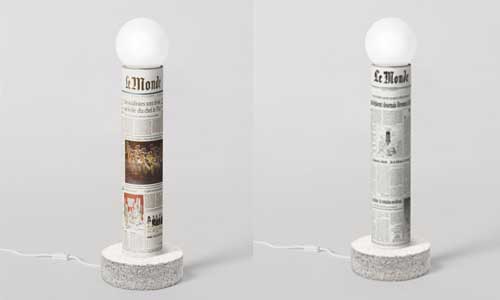
Tetra Pak is teaming up with the newspaper Le Monde and the design studio 5.5 in a unique partnership to create a collection of 80 unique lamps. This collection, titled “Le Monde à la Une,” has been crafted from recycled carton fibers provided by Essity.
To celebrate the 80th anniversary of Le Monde, Tetra Pak has partnered with the newspaper and the design studio 5.5 to create a collection of 80 unique lamps. Le Monde is organizing its Festival du Monde, which will take place from September 20-22, 2024, coinciding with the European Heritage Days. The festival’s main theme is the celebration of Le Monde’s 80th anniversary. Over the three days, festival-goers will experience building tours, workshops, concerts, and shows. The festival will be held at Le Monde’s headquarters and various locations in the 13th arrondissement of Paris. The festival program is free and open to the public.
The food packaging in service of the festival du Monde
As part of this partnership, Tetra Pak provides the material and its industrial expertise alongside studio 5.5 for the creation of this collection of 80 numbered design lamps, from 1944 to 2023. Each lamp is printed with a front page representing its respective year. Titled “Le Monde à La Une”, this lamp collection will consist of cardboard, newspaper, and fibers from recycled beverage cartons, processed at Essity’s site in Hondouville, Normandy. Essity is a global leader in hygiene and health.
This collection has been envisioned around the reading experience and will be designed and staged by the pioneering upcycling design studio 5.5.
The lamps will first be exhibited at Paris Design Week from September 5-14, 2024, and will be available for pre-sale from September 5, followed by the Festival du Monde from September 20-22, 2024.
Tetra Pak: beyond recycling, towards circularity
Tetra Pak’s initiative for Le Monde’s 80th anniversary is part of the company’s broader commitment to sustainability. Tetra Pak has long been committed to promoting and actively supporting recyclability and the circular economy.
Partnerships and innovations are at the heart of this strategy: the company collaborates with various actors to create new products from recycled packaging, such as furniture, building materials, and even clothing. The goal is clear: to create a future where all Tetra Pak packages are recycled (currently at 61%) and the materials from recycling are fully reused in new products.
Stéphanie Lahad, Sustainability Manager at Tetra Pak France, comments: “This project perfectly represents our commitment to recycling and material reuse by illustrating how our beverage cartons can have multiple lives. This collaboration allows us to highlight the versatility and durability of our packaging in partnership with Essity, which provided the fiber for our recycled cartons.Together, we demonstrate that an everyday consumer product can be transformed into a functional and environmentally friendly work of art. By giving a second life to our cartons, we promote a circular economy. This initiative is concrete proof of our determination to create innovative and sustainable solutions in partnership with stakeholders who share our vision.”
Eric Guazzaroni, Director of Professional Hygiene at Essity, adds: “The reuse of materials is one of the drivers and pillars of our activity. At Hondouville in the Eure, our technology allows us to recover up to 100% of the fibers contained in each food brick. The fibers used for the “Le Monde à la Une” lamps are identical to those we have been using for nearly 20 years to manufacture Tork® brand hygiene paper products (toilet paper, hand towels) offered by hotels, restaurants, businesses, industries, communities, or healthcare facilities to their customers. Combined with the implementation of intelligent systems promoting fair and responsible consumption and innovative services such as the collection of used hand towels from our customers to transform them into toilet paper, our solutions contribute to a more circular society, less resource-intensive, driven by cooperation between stakeholders and a collective approach to ecological transition.”

































